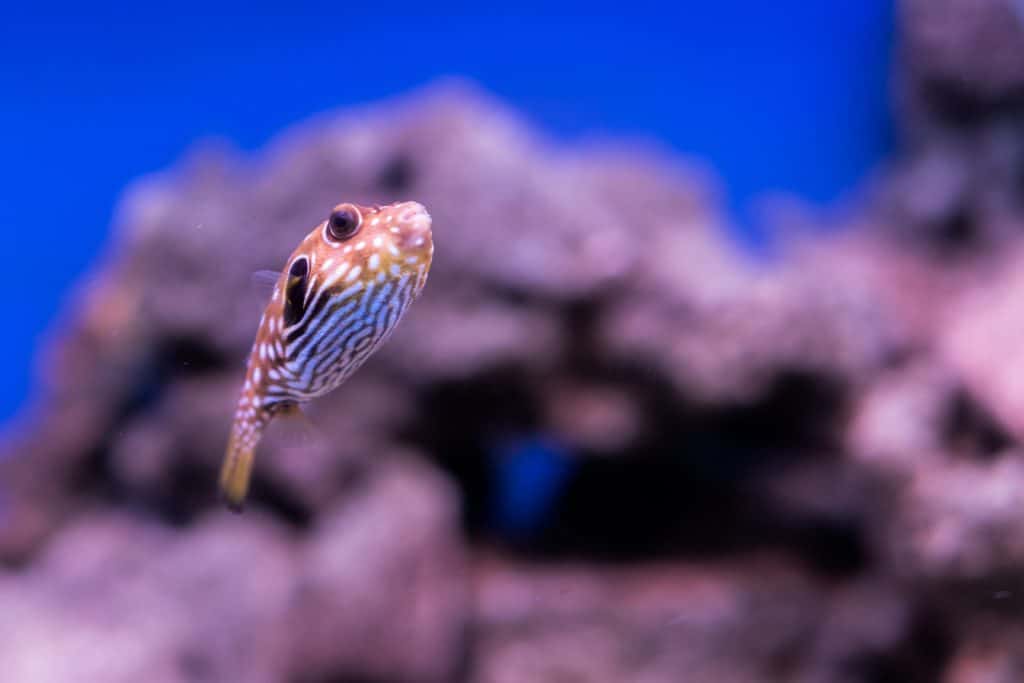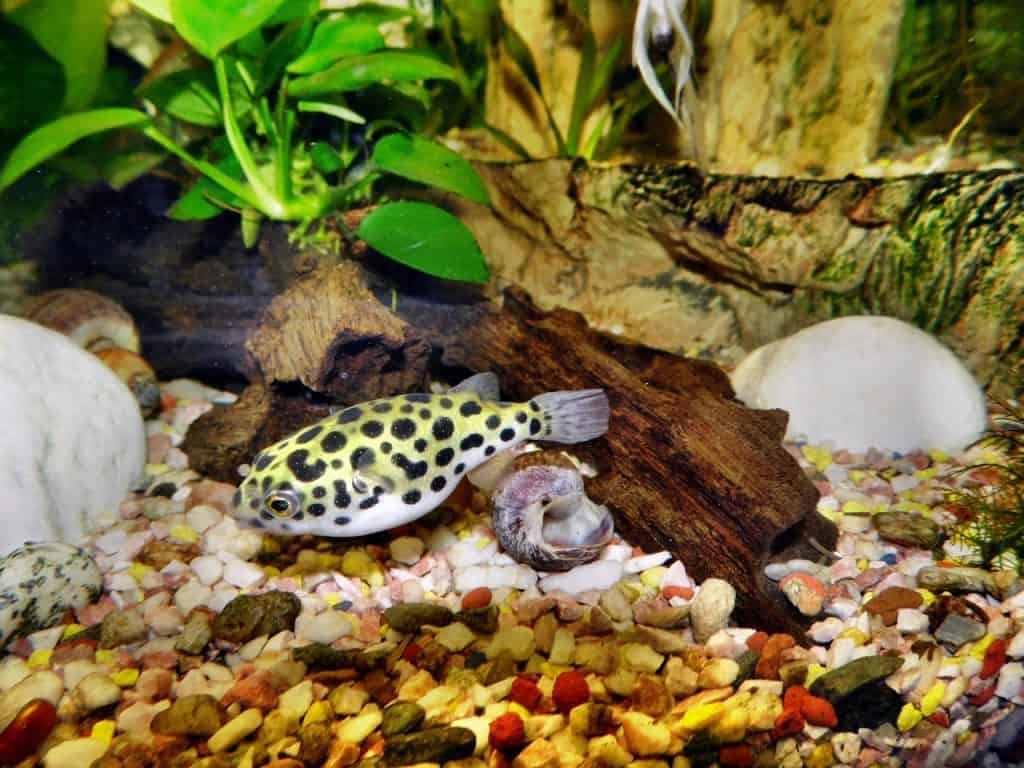
For experienced aquarium keepers, raising freshwater pufferfish can be a difficult task. A large tank is necessary and you must be able to filter the water quickly. However, we assume you already know this and will compare several varieties to find the one that you prefer.
We were able to gather 11 different species of freshwater pufferfish for you to examine so that you can decide if any are your favorites. We will show you how they look and give you some information about each breed. We’ll talk about aquarium size, filtration, color, and length to help you make an informed purchase.
These are the 11 types of freshwater pufferfish that we will be discussing with you.
1. Congo Puffer
Congo pufferfish are a native of the rivers in Africa, as their name suggests. They can grow up to 6 inches in length and will hide from predators by spending most of their time in the sand at bottom of the aquarium. There are many colors available including red, sand, and black. The Congo can also adapt to their environment, except for blue. They need a large tank because they are sensitive to nitrates. The water must be filtered as well as most pufferfish.
2. Dwarf Puffer

The Dwarf pufferfish can also be known as the Pygmy pufferfish or the Pea pufferfish. It is one of the smallest pufferfishes in the world, and rarely grows more than an inch and a half. Dwarf Puffer is currently listed as endangered by the International Union for Conservation of Nature due to habitat loss and overharvesting. Because of its small size and bright colors, this breed is extremely popular in aquariums. Dwarfs are easier to obtain the right size aquarium with the proper filtration than other breeds.
3. Fahaka Puffer
Fahaka Puffer, one of the largest pufferfish breeds, can grow to 16 inches in size when fully grown. These fish are very aggressive and should only be kept by experienced keepers. A tank that is at least 60 inches in length and has strong filtering capabilities will be required. Dense vegetation will also be needed. They can also bite you in the fingers when they are feeding.
4. Golden Puffer
The Golden Puffer is available in two versions: a light and a dark. The pufferfish’s body is white with yellow dots in the light version. The dark version has a black body with yellow dots. Their bodies are very round with small fins that extend far back. Their skin is covered with small, toothlike projections that look like sandpaper. These projections become more prominent when they puff up. When fully grown, I have seen fish that can grow to almost 20 inches in size.
5. Imitator Puffer

The Imitator puffer, also known as the Dwarf Malabar puffer, is another small pufferfish. Bright yellow is the color of this fish. While the males are brighter than the females, the females have darker spots on their bodies. Even though they are smaller, they still need an aquarium that holds at least 30 gallons.
6. MBU Puffer
MBU Pufferfish, a large pufferfish breed, can grow to 26 inches in length. Because of their large size, these fish can be difficult to keep in an aquarium. We recommend this breed to only experienced pufferfish keepers. MBU pufferfish have an unusual body pattern that can change with age.
7. Ocellated Puffer
One of the rarest breeds is the Ocellated pufferfish. This is a captive-bred fish that can now be found in rivers and streams throughout South Asia. This breed has its own personality and males will protect any eggs with fierce guardianship. They are more peaceful than other types and prefer to be kept in pairs. They can be kept in smaller aquariums than others, requiring only about 20 gallons. You will still need strong filtration.
8. Red-Eyed Puffer
The Red Eyed Puffer is an amalgamation of four pufferfish breeds that share the red eye. This pufferfish breed is more aggressive than others and can be more difficult to keep. These fish are more aggressive than others, so it is best to keep them alone in an aquarium. They rarely exceed 2 inches in length, but they do require a large tank to produce lots of waste. An aquarium should be at least 32 inches in length. You will need plenty of tall, live plants.
9. Puffer of Red-Tailed Dwarf Puffer
Red-Tailed Dwarf pufferfish, a small-sized species that can grow to approximately two inches in size at its largest, is very rare. They prefer slightly acidic water and aquariums that have plenty of live plants. This breed’s males are larger than their females and have darker brown bodies with lighter cream-colored stripes down their lower sides. Smaller females are more mottled brown with uneven markings and shapes. Red eyes and tail fins distinguish males from females.
10. South American Puffer
The South American Puffer is the only pufferfish that can live in groups in nature. It is one of the most difficult fish to keep in an aquarium. This breed is only recommended for experienced enthusiasts. We also recommend that you only purchase one if your tank can accommodate more than one. If properly maintained, their bright yellow and black stripes are striking against the background vegetation.
South American Puffers require a rectangular tank that is at least 47 inches in length. Water must be filtered well and dense plants planted. Because their teeth can overgrow, you will need to feed them hard food. You may also need to trim them manually.
11. Target Puffer
Target Pufferfish can grow up to 6 inches in length and need a tank that is at least 35 inches to be able to support them. Strong filtration is essential. The aquarium should move as much water as possible. Target pufferfish are active at night and are nocturnal predators. You can watch your Target puffer hunt by using moonlight.
Summary
If you can provide the right environment for pufferfish to thrive, it can be very rewarding. Many puffers can grow to be quite large and have personalities that are different from other fish. It can be difficult to find a large tank or filter the water correctly. This is why it is important to plan ahead. Many puffers will last for more than five years. If you are new to pufferfish, we recommend the Dwarf Puffer. A properly raised MBU Puffer will be the talk of your aquarium.
We hope that you enjoyed this guide to freshwater puffer fish, and have discovered some puffers you’d like to raise. Please share this guide on Facebook and Twitter if you found it useful and have learned something new.
Do freshwater puffer fish exist?
Freshwater puffers may be found in river systems across Southeast Asia, sections of India and Bangladesh, South America’s Amazon basin, and Africa’s Congo, Nile, and other rivers. The Gold-ringed Puffer, also known as the Mbu Puffer, may even be found in Lake Tanganyika!
Is it permissible to touch a pufferfish?
The spines and spikes on the pufferfish’s skin are extremely dangerous. Carry a poison known as tetrodotoxin (TTX), which is lethal to both other fish and humans. Avoid handling a pufferfish, especially if it is inflated. “Your hands may be harmed, and you may die.
Is Pufferfish can bite you?
The pufferfish does not bite. Pufferfish are one of the most deadly and lethal fish on the earth, although they do not sting or bite. They have various protection systems that make them one of the most difficult prey to consume for both animals and humans.
What happens if you get bitten by a puffer fish?
Symptoms usually appear 10 to 45 minutes after consuming the pufferfish venom and include numbness and tingling around the mouth, salivation, nausea, and vomiting. The symptoms can proceed to paralysis, loss of consciousness, and respiratory failure, which can result in death.
Is it painful for puffer fish to inflate up?
Inflating oneself full of water and stretching your skin taut can be quite uncomfortable, especially if your muscles aren’t used to it. Even if they do it sometimes only to stretch, puffing up might be distressing for a puffer.
How large can a freshwater puffer grow?
Puffer fish do they recognize their owners? Other fish known for being friendly to their owners include Maroon Clownfish, Pufferfish, Peacock Bass, Flowerhorns, Giant Gouramis, and Arowanas.
What is the most simple puffer fish to keep?
Dwarf puffers, also known as pea puffers or Malabar puffers, are probably the most popular and easiest freshwater puffer to keep.
Is it simple to care for freshwater puffer fish?
This is not an easy fish to care for, but it is rewarding if you know what you’re doing. If you are already familiar with fishkeeping, we recommend getting a freshwater puffer fish. If you’re just starting out, this isn’t the fish for you.
Is a heater required for freshwater puffer fish?
Freshwater pufferfish require water that is free of salt, has a pH between 7.0 and 7.6, and is around 76°F. Puffer aquariums typically do not require water heaters unless kept in a room with a temperature below 74°F.